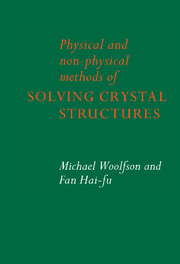Book contents
- Frontmatter
- Contents
- Preface
- 1 The basics of X-ray diffraction theory
- 2 The Patterson and heavy-atom methods
- 3 Direct methods
- 4 The basics of isomorphous replacement and anomalous scattering
- 5 Further aspects of the isomorphous replacement method
- 6 Use of anomalous scattering data
- 7 Phase extension and refinement
- 8 Multiple-beam scattering methods
- References
- Sources of non-original figures
- Index
5 - Further aspects of the isomorphous replacement method
Published online by Cambridge University Press: 24 November 2009
- Frontmatter
- Contents
- Preface
- 1 The basics of X-ray diffraction theory
- 2 The Patterson and heavy-atom methods
- 3 Direct methods
- 4 The basics of isomorphous replacement and anomalous scattering
- 5 Further aspects of the isomorphous replacement method
- 6 Use of anomalous scattering data
- 7 Phase extension and refinement
- 8 Multiple-beam scattering methods
- References
- Sources of non-original figures
- Index
Summary
Introduction
The crystal structure analysis of a protein would be a routine procedure provided that two or more heavy-atom derivatives with good isomorphism to the native protein were available (chapter 4). Unfortunately, in practice this is often not the case. Usually there will be little difficulty in preparing one heavy-atom derivative that is isomorphous with the native protein. However, finding a second isomorphous derivative may not be straight forward so that the use of single isomorphous replacement (SIR) data is preferable if there is some way to resolve the intrinsic ambiguity of the method in the non-centrosymmetric case (§4.1.3). The double-phase method (§4.1.6) is one way of doing this but it usually gives a rather noisy map. There is now described a noise-filtering technique which can be used to develop better information in such a situation.
Resolving the SIR phase ambiguity in real space: Wang's solvent-flattening method
Protein structures are characterized by having large contiguous solvent regions surrounding other regions of somewhat higher average density within which the protein exists. The contrast between the ordered structure (protein, sometimes with some solvent molecules) and background (disordered solvent) is much less than for small-molecule structures and this is one of the reasons, additional to other factors including their size and complexity, which make protein structures difficult to solve.
The first critical step in Wang's method (Wang, 1981, 1985) is to define the molecular boundary from a noisy electron density map. Following that, the densities inside the protein envelope are raised by a constant value and then densities lower than a certain value are removed. Outside the protein region, the density is smoothed to a constant level.
- Type
- Chapter
- Information
- Physical and Non-Physical Methods of Solving Crystal Structures , pp. 146 - 166Publisher: Cambridge University PressPrint publication year: 1995

